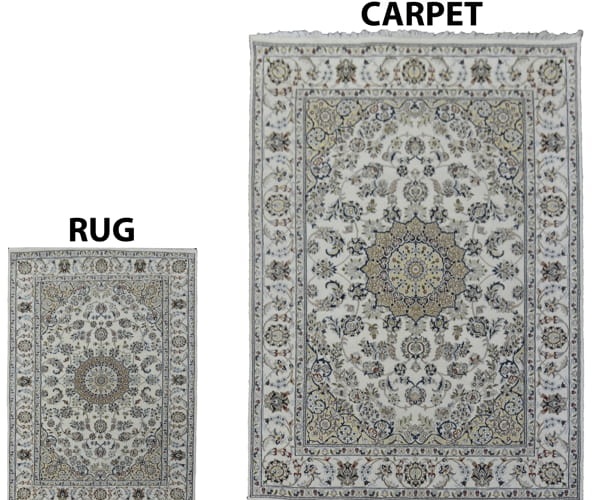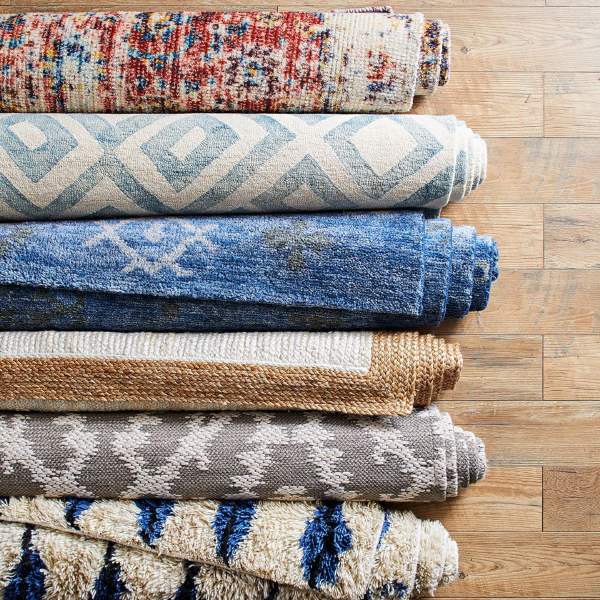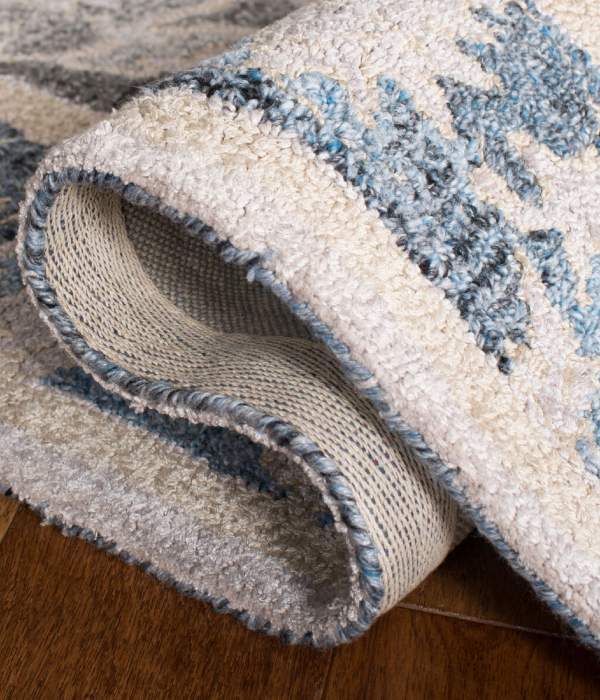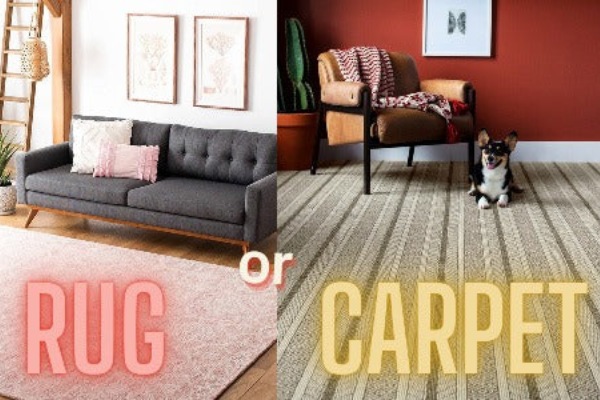Rugs and carpets are the most common types of floor coverings. However, many use the terms interchangeably because they serve similar purposes. Both rugs and carpets are key components of interior design. They enhance the aesthetic appeal of a room while providing practical floor coverage. Even though they do similar functions, it is important to note the distinct differences between rugs and carpets. Here we now go on to further details about about rugs and carpets.
A Short Definition of Rug and Carpet
Generally, rugs are smaller than carpets in terms of size. It is about 2 to 3 feet. Similarly, the materials will be thicker and designed to cover specific areas of the floor. On the other hand, carpets cover the whole floor and sometimes could be from wall to wall. People typically use rugs as features or decor for specific parts of a room, such as below a coffee table or near an entrance. Carpets are usually nailed down or attached and cover most of the house, except for areas like kitchens and bathrooms.
Factors to be considered
Carpets
- Carpets are recognized for their ability to add warmth and comfort.
- It provides insulation, helping to regulate temperature.
- Additionally, it is effective in reducing noise which is particularly valuable in areas with heavy foot traffic or in rooms where acoustics matter.

Rugs
- Rugs come in many different styles, sizes, and shapes, making them very flexible for decorating and placing in various spots.
- Unlike carpets, which are usually installed and stay in one place, rugs can be moved, swapped, or layered easily.
- They serve as a tool to introduce color, patterns, or texture into a room.
- Furthermore, they are portable and you can update them seasonally or based on personal preference.
Materials and Texture
Rugs and carpets are different in terms of materials and design. Rugs often feature intricate patterns and are handcrafted from natural fibers. In contrast, carpets are more resilient because they are made from synthetic materials and are often machine-made. Additionally, they come with different design elements such as varying pile heights and patterns.
Rugs
Rugs can be crafted from either natural fibers like wool, cotton, or silk, or synthetic materials such as polyester and nylon. Each of these materials has unique qualities that affect how durable the rug is, how well it resists stains, and its texture. Some rugs are hand-woven with detailed patterns and designs. They are made from high-quality materials like silk and wool. It often required months to complete. Similarly, there are machine-made rugs that are less time-consumable. It is designed for uniformity and affordability and usually features bright colors and geometric shapes for a stylish, modern look.
Carpets
Carpets are also made from different materials, such as nylon, polyester, wool, and polypropylene. Understanding the benefits and drawbacks of each carpet material helps you make a better choice for your needs. For example, if you need a carpet for a high-traffic area, nylon is the finest option because it is extremely durable and resilient. Similarly, polyester is stain-resistant and comes in a range of bright colors. Wool is soft and durable, but it requires more care. Furthermore, polypropylene is affordable and resistant to moisture and fading.
Rug or Carpet: Which is Easier to Care For?
Maintaining rugs and carpets is somewhat similar. Regular vacuuming is crucial for both to effectively remove dust and allergens. This routine cleaning not only helps to maintain their aesthetic appeal but also extends their lifespan. Deep cleaning ensures that they stay fresh and in good shape over time.

However, rugs are generally easier to clean compared to carpets. Many rugs can be washed in a machine and replaced quickly if needed. They are portable, so you can easily lift them for spot cleaning or vacuuming and even take them outside for a deep clean. This makes rugs more convenient and practical.
On the other hand, carpets are attached to the floor which makes it more challenging to clean. They can soak up spills and odors easily because of their structure and how they are fixed in place. As a result, carpets often need professional cleaning services to properly remove stains and odors. Further, maintaining carpets can also be time-consuming.
Which is More Expensive Rug or Carpet?
Rugs are an affordable way to improve home decor compared to other flooring options. Some rugs, especially hand-knotted ones made from natural fibers like silk or wool, can be quite pricey. However, carpets have higher overall costs due to the full-room coverage, installation expenses, and ongoing cleaning maintenance.
Rugs are easy to install, so you don’t have to pay for installation. On the other hand, wall-to-wall carpets need to be installed by professionals, which increases the total cost. This professional installation includes charges for labor, underlay, and extra materials. Rugs are also simple to clean and maintain with regular vacuuming and occasional professional cleaning. Carpets may need more frequent cleaning and maintenance to prevent stains and wear, which can lead to higher costs over time.
Conclusion
In conclusion, Rugs and carpets are essential home decor items that help to enhance the aesthetic appeal of the room and provide practical floor coverage. Rugs are designed to cover specific areas of the floor while carpets cover the entire floor area. They come in various styles and materials, from luxurious hand-woven designs to affordable machine-made options. Carpets are known for their warmth, comfort, insulation, and noise reduction while rugs come in various styles, sizes, and shapes, making them portable and easy to update. When it comes to maintenance, rugs are generally easier to clean and replace. On the other hand, carpets require more effort and professional cleaning due to their full-room coverage and attachment to the floor. Rugs are more bu budget-friendly, whereas carpets come with higher costs for installation and ongoing maintenance. Understanding these differences can help you choose the right option to best suit your home’s needs and your personal preferences.

Also read, Carpet vs. Hardwood Flooring! Which is Better?
Frequently Asked Questions
1. What’s the difference between rugs and carpets?
Rugs are smaller and designed to cover specific areas of a floor, such as under a coffee table or near an entryway. Carpets, however, cover the entire floor from wall to wall and are installed permanently.
2. What materials are used in rugs and carpets?
They are made of natural fibers like wool, cotton, or silk, or of synthetic materials such as polyester and nylon. They can be handwoven or machine-made.
3. Is a rug cheaper than a carpet?
Rugs are usually cheaper as compared to carpets. Carpets involve higher overall costs due to full-room coverage, installation expenses, and ongoing maintenance. Meanwhile, rugs can be installed by yourself, avoiding installation costs, while carpets require professional installation.
4. Which is easier to maintain a rug or a carpet?
Rugs are easier to maintain, as they can be moved, cleaned easily, and replaced if necessary. While carpets are more challenging as they require professional cleaning services, which can be time-consuming and costly.
5. How do rugs and carpets affect home decor?
Both rugs and carpets enhance the aesthetic appeal of a room. Rugs add style and color in specific areas, while carpets provide a uniform look and feel across the entire floor.
